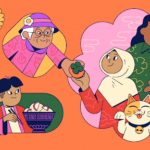
Who is a successful, professional dancer in India today? In the not so distant past, these persons would have been easy to identify. They would have come from an elite, affluent background or been a male dancer from a hereditary lineage. Women professional dancers from such lineages, like the tawaifs and the devadasis, had already been condemned as prostitutes in independent India.
But today the picture is far more complex and diverse, as the Indian dance horizon has grown broader and more inclusive. Economic liberalisation in the 1990s created a great turbulence in the cultural sphere. The momentum of change facilitated various kinds of boundary crossings among cultural forms – between high and low, classical and folk, Indian and western – breaking down categories and classifications. As a result, different cultural forms and practices emerged, propelled by perhaps the most important aspect of this chaotic newness – the spread of media and electronic communication.
An empowering hybrid
As Bollywood dance spread like wildfire, the fiercely protected hierarchies of classical, folk, and popular dances were replaced by the celebration of hybridity and cosmopolitanism in urban India. Bollywood-inspired dance reality shows exploded on TV networks as new consumers, dancers, and choreographers took centre stage in shaping a new Indian identity. A new aesthetics of remix inspired by MTV and Bollywood filtered into the dance vocabulary of ordinary Indians who wanted to dance like Shiamak Davar and Remo D’Souza.
A little-known choreographer of a TV dance reality show in Kolkata summarised this new phenomenon succinctly: “Now, everybody wants western dance, nobody wants to learn Indian classical or folk. You will see on the street corners and alleyways where they used to have advertisements for classical Indian or folk classes, they now have western, salsa, jazz, contemporary, and Bollywood.”
I have looked at this transition in a new book titled This is How We Dance Now. I argue that dance creates a specific kind of experience and raises an important set of debates on India’s ongoing encounter with modernity. The growth of the media and the globalisation of Indian culture have led to new hybrid and spectacular visual entertainments. This has changed everything: aesthetics, of course, and how we see the body, and what constitutes empowerment, and how gender and sexuality are performed, and how cultural authority is defined, and how morals and ethics – social judgments about what is “good” or “bad” behavior – shift.
I locate Indian dance at the crossroads of this cultural, moral, and aesthetic transformation in society. It is not possible to summarise all that is in the book in these few hundred words. Let me follow one track – which is that of the ordinary dancer of reality shows.
New embodiments of femininity and masculinity
There is a wide range of people who make a living from dance now. Some are established and even well-known in local circles. Then there is a large cross-section of emerging young women and men who are making a living as dancers, choreographers, and teachers.
I followed a few of these dancers and choreographers in various settings: from Film City studios in Mumbai to the auditions of Dance India Dance in Kolkata. I talked to them about their dreams, struggles, and possibilities.
The liberalisation of the Indian economy is a multidimensional process. It means different things to different people. Some see it through an ideological lens: either of “good” capitalism that empowers and liberates people, or of “bad” capitalism that empowers and enriches only those who are already powerful and rich.
Reality is probably somewhere in between. This reality is one in which there is the possibility of upward mobility for some sections of the lower middle and working classes.
The reality TV world of dance is a controversial (some say exploitative) slice of this story of class mobility and visibility for an aspirational generation. The people I talked to are not part of the IT or the retail industry. They do not work at call centres or designer sari stores in malls. They are the cultural workers of a new image economy that is breaking all the rules and norms of the past.
They are creating new embodiments of femininity and masculinity. They are breaking many ideas about middle-class respectability. They dream of fame and celebrity but are willing to settle for financial independence and stability. And as they struggle to define themselves, they change how their families see them and what is acceptable and moral.
The grandmother of one of the female dancers at a reality show asked me: “What is the right conduct for my granddaughter who wants to be a dancer? She has a talent for dancing but we are not affluent. I encourage my granddaughter to dance on reality shows as long as she is able to. The time has come for women to step out and claim a place in this changing world.”
Things are messy now. There are hundreds of TV channels beaming visuals of thousands of lifestyles. Devout, religious, patriarchal, casteist, violent, carefree, sexually active, ambitious, mod, hip, licentious, superficial, profound, bleeding, grasping, climbing, achieving, dancing. The time has come for us – those who have the privilege of writing about this – to step out of our narrow confines and genuinely try to understand this changing world.
Pallabi Chakravorty is the author of Bells of Change: Kathak Dance, Women, and Modernity in India and the director of Courtyard Dancers (Courtyarddancers.org). She teaches at Swarthmore College (USA) in the Department of Music and Dance.
[“source-Scroll”]










